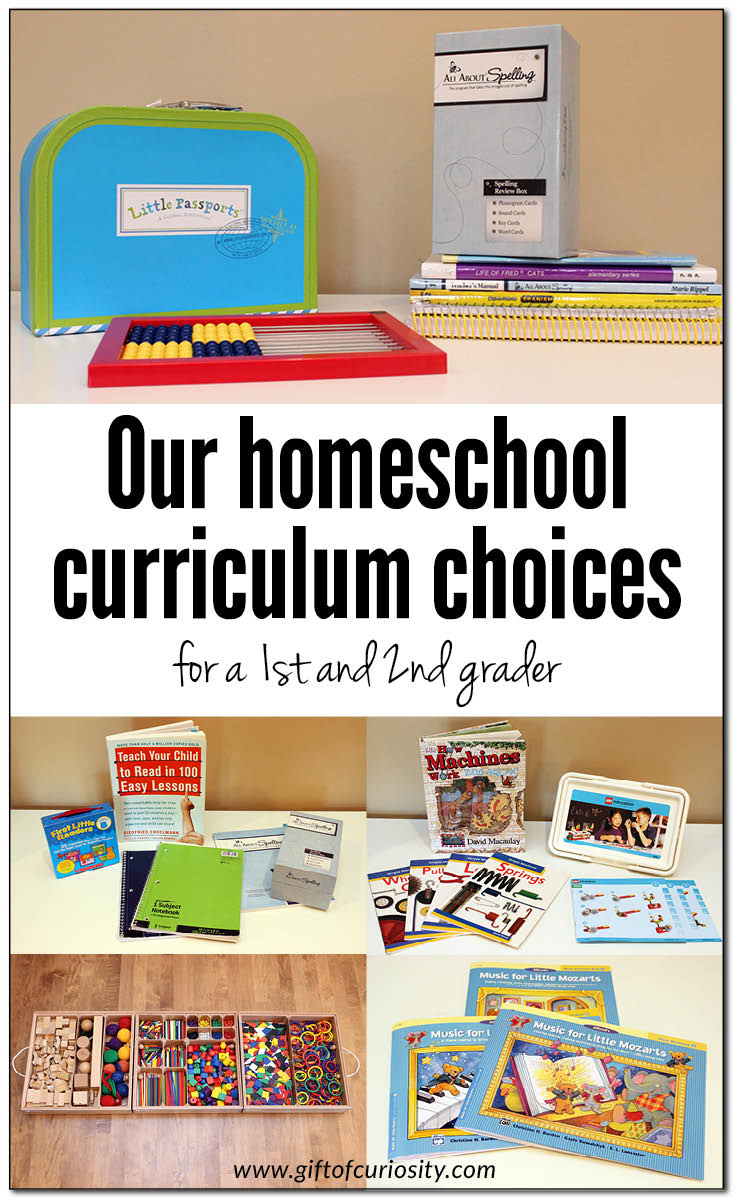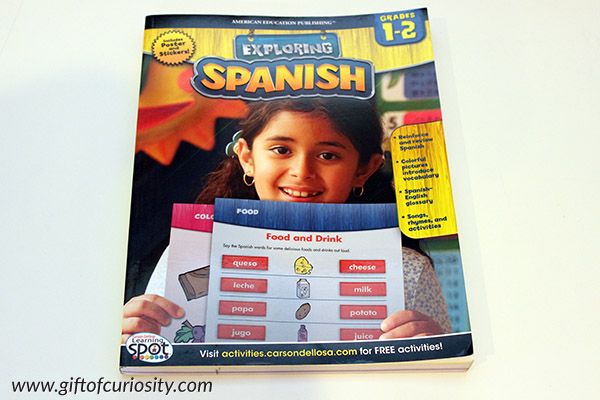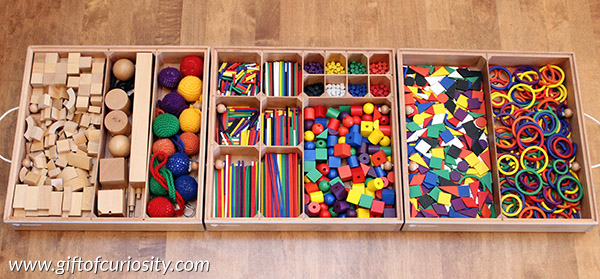This post may contain affiliate ads at no cost to you. See my disclosures for more information.
We’ve been homeschooling for two years now, and are about to begin our third year. My son, QBoy, will be going into second grade and my daughter, XGirl, will be going into first grade.
Over the last two years I’ve experimented with a variety of curriculum and ways of learning. In this post I’m sharing the curriculum choices I have made for our homeschool this coming year.

Language arts
There are a lot of components to what we do in language arts. For example, we do activities that work on reading, fiction writing, non-fiction writing, spelling, and grammar.
XGirl (going into first grade): For reading this coming year, XGirl will be finishing the lessons in Teach Your Child to Read in 100 Easy Lessons. She did about half the lessons last year and will hopefully finish the book this coming year.
In addition, she also does a lot of reading. She is currently working her way through the second set of First Little Readers. We have previously used the BOB books and may continue to do so this year. And each week she gets books from the library that she reads herself and that my husband and I read to her.
For reading, I also print off worksheets for her to work on specific skills. Some of my favorite resources for language arts worksheets are from The Measured Mom and This Reading Mama. For example, this past year I used The Measured Mom’s Short Vowel Word Family Mats and This Reading Mama’s 1-2-3 Flip It! Game. I’ll be scouring these blogs this year to find more helpful worksheets.
For spelling, XGirl will be starting with All About Spelling Level 1 from All About Learning Press. I’ve heard excellent reviews of this curriculum from other homeschoolers, and I am impressed by the research behind it. So I am hopeful it will be a good fit for her.
For non-fiction writing, XGirl has a spiral notebook that she uses to write a story from her imagination each week. I like keeping all of her writing in one place because it makes it easy to see the progression in her skills over time.
I do not plan to start any non-fiction writing with XGirl at this time. However, as her skills develop over the next few months, I may begin teaching her some of the fundamentals of non-fiction writing.
Similarly, I do not plan to start any grammar work with XGirl for at least a few months until her reading skills are stronger.
QBoy (going into second grade): QBoy finished the lessons in Teach Your Child to Read in 100 Easy Lessons a few months ago. At this time I am not using any formal curriculum to continue developing his reading skills. He reads books of his choosing each week and I explain reading rules to him as he comes across them. As long as he continues to progress, this may be all we do. If he stalls with his reading development at some point, I’ll consider using All About Reading from All About Learning Press.
As with XGirl, I do still print off worksheets that I find on the internet for him to do, based on his current needs. We’ve enjoyed activities from the Low-Prep Long Vowels Games Pack and the Roll and Read Phonics Games Pack from This Reading Mama and Blends and Digraphs Bingo from The Measured Mom. I will continue to look at both sites for other worksheets to use for QBoy.
For fiction writing, once a week QBoy uses his spiral notebook to write a story about anything he wishes. His stuffed animals and Star Wars seem to make a lot of appearances in his stories. 🙂
For non-fiction writing, we are using the strategies taught in Step Up to Writing. Years ago when I taught literacy programs in an after school setting I was trained in this curriculum for teaching non-fiction writing. The biggest surprise for me in the curriculum was how much it helped me with my own writing! I am looking forward to revisiting it with QBoy this year as he learns the fundamentals of non-fiction writing.
For grammar, I have been using a Montessori approach inspired by my KHT Montessori language manual and other Montessori grammar information I have found online. I purchased a set of wooden Montessori grammar symbols and QBoy has been using them to identify parts of speech in writing.

Math
RightStart Mathematics
Our main math curriculum is RightStart Mathematics by Activities for Learning. I love, love, LOVE RightStart Math! I really can’t say enough about how brilliant I think this program is and how well it has worked for both of my kids.
There are three reasons why I think RightStart is the best math curriculum around.
First, it teaches really good mathematical thinking (which I believe math education in the United States, as a whole, does not do). This program de-emphasizes counting, uses visualization of quantities, and provides lots of strategies and visual pictures for learning math facts. Understanding and problem solving are emphasized throughout. The curriculum, which is inspired by Montessori principles, uses a specially designed abacus that helps kids visualize numbers in quantities of 5s and 10s.
Second, there is very little need for kids to memorize math facts in a boring or rote way. Instead, they naturally learn math facts through fun games and hands-on practice with the specially designed abacus.
Third, the curriculum introduces topics so gently that my kids have very rarely struggled to learn math. It always introduces concepts in a hands-on way that is easy for kids to understand, and then moves from a concrete understanding to a more abstract understanding. The progression from lesson to lesson is so smartly planned that my kids, including my daughter who has some learning challenges, have rarely had to struggle.
My kids both honestly and truly love doing RightStart each week. So what more could I ask for?!?
We initially purchased our RightStart curriculum through the Homeschool Buyer’s Co-op, but it is also available through from Activities for Learning.
DreamBox Math
DreamBox is an online math program that coordinates very nicely with RightStart because it uses the same abacus, albeit in digital format. My kids get on the computer or iPad a couple of times a week to work on DreamBox, and they love it. We purchased our DreamBox subscription at a significant discount through the Homeschool Buyer’s Co-op.
The program is easy to navigate, includes a variety of interesting math exercises to work on, and includes a parent dashboard so I can monitor how my kids are doing.
DreamBox and RightStart make an awesome combination.
Life of Fred
The other math curriculum we use as a supplement is the Life of Fred elementary math series (you can find more information about it on the Life of Fred website).
Fred is a very non-traditional math curriculum. It is actually a series of quirky stories about a five-year-old math professor named Fred who teaches at KITTENS University in Kansas. Each short chapter features Fred engaged in some activity where he needs to use math. At the end of each chapter is a small series of questions for kids to practice some of the math concepts that Fred had used.
However, Life of Fred does not just teach math. It also introduces concepts from history, science, foreign language, and language arts.
My kids absolutely adore Fred and his zany adventures. Life of Fred has been a fun, amusing, and helpful addition to our math curriculum.
XGirl: Math is XGirl’s favorite subject, probably because the curriculums we use are so awesome. She will be working through RightStart Level B this year. She will also be starting the year with the second book in the Life of Fred elementary math series titled “Butterflies.” We do about one chapter a week so I expect her to move into the third Life of Fred book and possibly the fourth before the year is over. She will continue to do DreamBox a couple of times a week as well.
QBoy: Math is also QBoy’s favorite subject, and he has developed some really strong math skills with very flexible ways of thinking about numbers. More importantly, he feels really good about himself and his math skills. He will be working on RightStart Level C this year. He will also be starting the third book in the Life of Fred elementary math series titled “Cats.” Doing one chapter a week, I expect he’ll finish both the third and the fourth Life of Fred books by the end of the school year. He will also continue to work in DreamBox a couple of times a week as well.

Science
Science is my favorite subject to teach, and over the last two years I have enjoyed putting together my own science curriculum drawn from a number of resources.
As in previous years, we will not use one particular book or curriculum for our science learning. We will start the year learning about Simple Machines using our LEGO Education set along with several books and video resources. My kids are LEGO fanatics so I know they will enjoy getting to build and learn with LEGO. (I originally bought our LEGO Education Simple Machines set from the Homeschool Buyer’s Co-op at a huge discount. At the time of this writing I do not see it available at the co-op, but the co-op does feature LEGO Education materials from time to time.)
Later in the year I will probably teach small group science classes to a multi-age group of homeschoolers using some of the FOSS curriculum for first through third graders.
And if you’ve seen the science section on my blog, you know that we do lots of different hands-on science activities on a regular basis.
QBoy and XGirl do all of their science activities together.

Social studies
We don’t follow one particular curriculum for social studies. Instead, we learn about social issues through discussing what we see in our community and in the media. At 6 and 7 years old, my kids are already very aware of racial justice and sexism.
We also learn history by visiting museums and by watching videos online.
This coming year I plan to spend some time focusing on world geography using our Little Passports set.
QBoy and XGirl do all of their social studies activities together.

Music
My kids have been taking piano lessons for a little less than a year now with an instructor near our home. This is the one subject that I have basically nothing to do with, other than driving my kids to and from their lessons. I can’t read music and haven’t played an instrument since fifth grade, so I feel completely unqualified to help in this area.
My husband, who played some instruments in college, helps the kids with their music homework. The teacher uses the Music for Little Mozarts curriculum, and my kids are really enjoying it. They especially like that they get a new stuffed animal when they move into a new book. Both kids are currently working in the third book of this series.

Spanish
I am fluent in Spanish, but I’m sad to say that I have not, until recently, made it a priority to speak to my kids in Spanish. However, our family traveled to Mexico last spring and my kids met my Mexican host family that I have known since I was 16. My kids had a blast playing with my Mexican brothers and sisters, and it motivated them to actually learn some Spanish.
So I recently enrolled them in a Spanish course once a week, where the teacher is using the Exploring Spanish workbook. I supplement their learning by introducing words here and there while we are out and about.
In fact, we have become well known among the staff at our local grocery store because we always practice Spanish in the produce section, where my kids are learning the names of different fruits and vegetables, learning numbers as they count out the produce, and learning colors as we talk about the food we are buying. Some of the Spanish speaking staff at the store will usually say hi to my kids in Spanish as well, giving them additional opportunities to practice with native speakers.
A homeschooling friend of mine who is a native Spanish speaker is hoping to begin offering Spanish classes in the fall, so I may sign my kids up to work with her as well. I’ve also begun to let them watch movies dubbed in Spanish. I pick movies that they have already watched in English, which provides them with enough context to pick up some Spanish words here and there.

Art
I do not use a particular art curriculum, but we do plenty of art activities throughout the year. You can see some of what we’ve done on my Arts and Crafts Activities page. We will continue to do a variety of art projects throughout the year.
Other learning
My biggest priority is to provide hands-on learning opportunities. We own a Spielgaben set of high quality wooden toys that we play and learn with on a regular basis. Spielgaben materials are great for teaching math concepts, and they also integrate well with other subjects including science and language arts. I have a Pinterest board dedicated to sharing Spiegaben activities from other bloggers.

We also own a set of Zome tools. I purchased the Zome STEM + Educator Kit from the Homeschool Buyer’s Co-op a year ago and we’ve used it to work on a number of concepts including shapes, spinning machines, bubbles, and snowflakes.
When I was teaching homeschool science classes to a group of kids ranging in age from kindergarten through eighth grade last fall, Zome was a hit with all of the kids. I am not yet sure how we’ll use Zome this year, but I am looking forward to exploring some new topics with it.
So that’s our plan for this coming year! What curriculum recommendations do you have?
More homeschooling resources
More homeschooling posts from Gift of Curiosity:
- Why we initially decided to homeschool
- 13 reasons why homeschooling works for our family
- Tour of our homeschool room






Have you ever posted a daily schedule/routine that you generally follow? I have a 1st & 3rd grader, and I’m always curious about how other homeschoolers spend their days.
I have not, but I may share some “day in the life” posts at a future time. 🙂